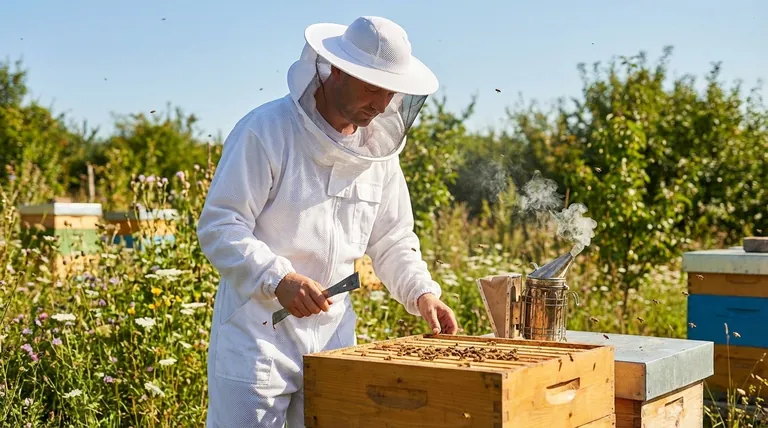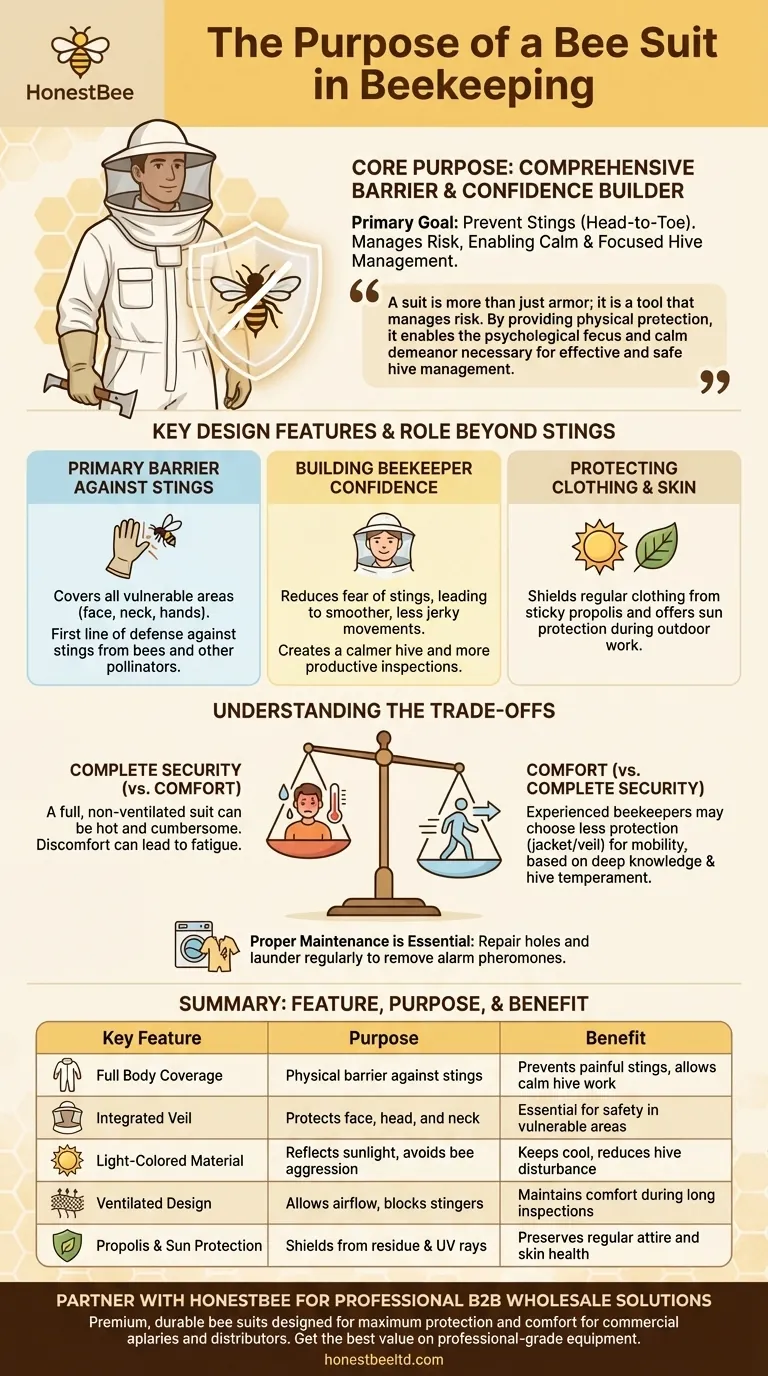At its core, a bee suit is a specialized form of personal protective equipment designed to create a comprehensive barrier between the beekeeper and the bees. Its primary and most critical purpose is to prevent bee stings, covering the wearer from head to toe. This protection allows a beekeeper to work calmly and confidently within and around a hive.
A beekeeping suit is more than just armor against stings; it is a tool that manages risk. By providing physical protection, it enables the psychological focus and calm demeanor necessary for effective and safe hive management.

The Suit's Role Beyond Sting Prevention
While preventing stings is the main objective, the value of a quality bee suit extends further, impacting the beekeeper's effectiveness and confidence.
The Primary Barrier Against Stings
A full suit covers every inch of skin, including the most vulnerable areas like the face, neck, and hands (when paired with gloves). This physical barrier is your first and most effective line of defense against the defensive stings of honey bees and other aggressive pollinators like yellow jackets.
Building Beekeeper Confidence
For both new and experienced beekeepers, feeling secure has a direct impact on behavior. A protected beekeeper is less likely to make sudden, jerky movements that can alarm bees, leading to a calmer hive and a more productive inspection.
Protecting Clothing and Skin
Beehives contain more than just bees. A suit protects your regular clothing from being stained by propolis, a sticky, resinous substance bees produce. It also offers a significant degree of sun protection during long hours spent working outdoors.
Key Design Features of a Bee Suit
The effectiveness of a bee suit comes from specific design choices that have been refined over time to balance protection, comfort, and visibility.
The Critical Role of the Veil
The veil is arguably the most important component. It protects your face, head, and neck. Stings in this area are particularly painful and dangerous, making a secure, well-designed veil non-negotiable for safe beekeeping.
Material and Color
Bee suits are typically white or light-colored. This is intentional, as light colors reflect sunlight, helping to keep the beekeeper cooler. Dark colors can also be perceived as a threat by bees, as they may resemble natural predators like bears.
Modern suits often feature ventilated materials, which consist of multiple layers of mesh that allow for airflow while maintaining a gap too wide for a bee's stinger to cross.
Modular vs. Full Coveralls
Suits can be purchased as an all-in-one jumpsuit (coverall) or as separate jackets and pants. Jumpsuits offer the most complete protection with no gap at the waist, while separate jackets offer more flexibility for quick tasks or for beekeepers who feel comfortable with less coverage.
Understanding the Trade-offs
Choosing to wear a bee suit, and which type to wear, involves balancing safety with other practical considerations.
Comfort vs. Complete Security
A full, non-ventilated suit can become extremely hot and cumbersome, especially in warm climates. This discomfort can lead to fatigue and rushed work. This is the primary trade-off against the absolute security it provides.
Experience and Hive Temperament
Many highly experienced beekeepers choose to wear less protection, such as only a veil and jacket. This decision is based on their deep understanding of bee behavior, the specific temperament of their hives, and their personal comfort with the risk of being stung. This is not recommended for beginners.
Proper Maintenance is Essential
A suit's protection is compromised by holes or tears. It's also crucial to launder your suit regularly. Bee stings can leave behind alarm pheromones that may provoke more aggressive behavior from bees on subsequent inspections.
Making the Right Choice for Your Goal
The right protective gear depends on your experience level, climate, and beekeeping philosophy.
- If your primary focus is maximum safety as a beginner: A full, light-colored coverall suit, ideally ventilated, provides the most comprehensive protection and builds confidence.
- If your primary focus is mobility for quick hive checks: A high-quality jacket and veil combination may be sufficient, especially if you know your hives have a calm temperament.
- If your primary focus is working in a hot climate: Prioritize investing in a fully ventilated suit to mitigate the risk of overheating during long inspections.
Ultimately, the right bee suit is the one that allows you to work with your bees safely, calmly, and effectively.
Summary Table:
| Key Feature | Purpose | Benefit |
|---|---|---|
| Full Body Coverage | Creates a physical barrier against bee stings | Prevents painful stings and allows calm hive work |
| Integrated Veil | Protects face, head, and neck from stings | Essential for safety in vulnerable areas |
| Light-Colored Material | Reflects sunlight and avoids bee aggression | Keeps beekeeper cool and reduces hive disturbance |
| Ventilated Design | Allows airflow while blocking stingers | Maintains comfort during long inspections |
| Propolis & Sun Protection | Shields clothing from sticky residues and UV rays | Preserves regular attire and skin health |
Ready to enhance your beekeeping safety and efficiency? At HONESTBEE, we supply commercial apiaries and beekeeping equipment distributors with premium, durable bee suits designed for maximum protection and comfort. Our wholesale-focused operations ensure you get the best value on professional-grade equipment. Contact us today to discuss your specific needs and discover how our protective gear can support your beekeeping success!
Visual Guide

Related Products
- Cotton Beekeeping Suit and Round Hat with Veil Bee Keeper Protective Gear
- Beekeeping Jacket with Hood and Veil for Beekeepers
- White Beekeeping Protective Suit and Hat with Fencing Veil for Beekeepers
- Professional Beekeeping Suit for Kids and Girls Childrens Bee Keeper Suit
- Beekeeper Cowboy Hat and Veil for Beekeeping
People Also Ask
- How should a bee suit be cleaned? Protect Your Investment and Ensure Apiary Safety
- How should a beekeeping suit be hung to maintain its shape? Protect Your Investment with Proper Storage
- What factors should be considered when choosing a beekeeping suit? Balance Safety, Comfort & Performance
- Do beekeeping suits completely prevent stings? Maximize Your Apiary Safety with the Right Gear
- What are the benefits of a fully ventilated beekeeping suit? Stay Cool and Protected in Hot Climates



















